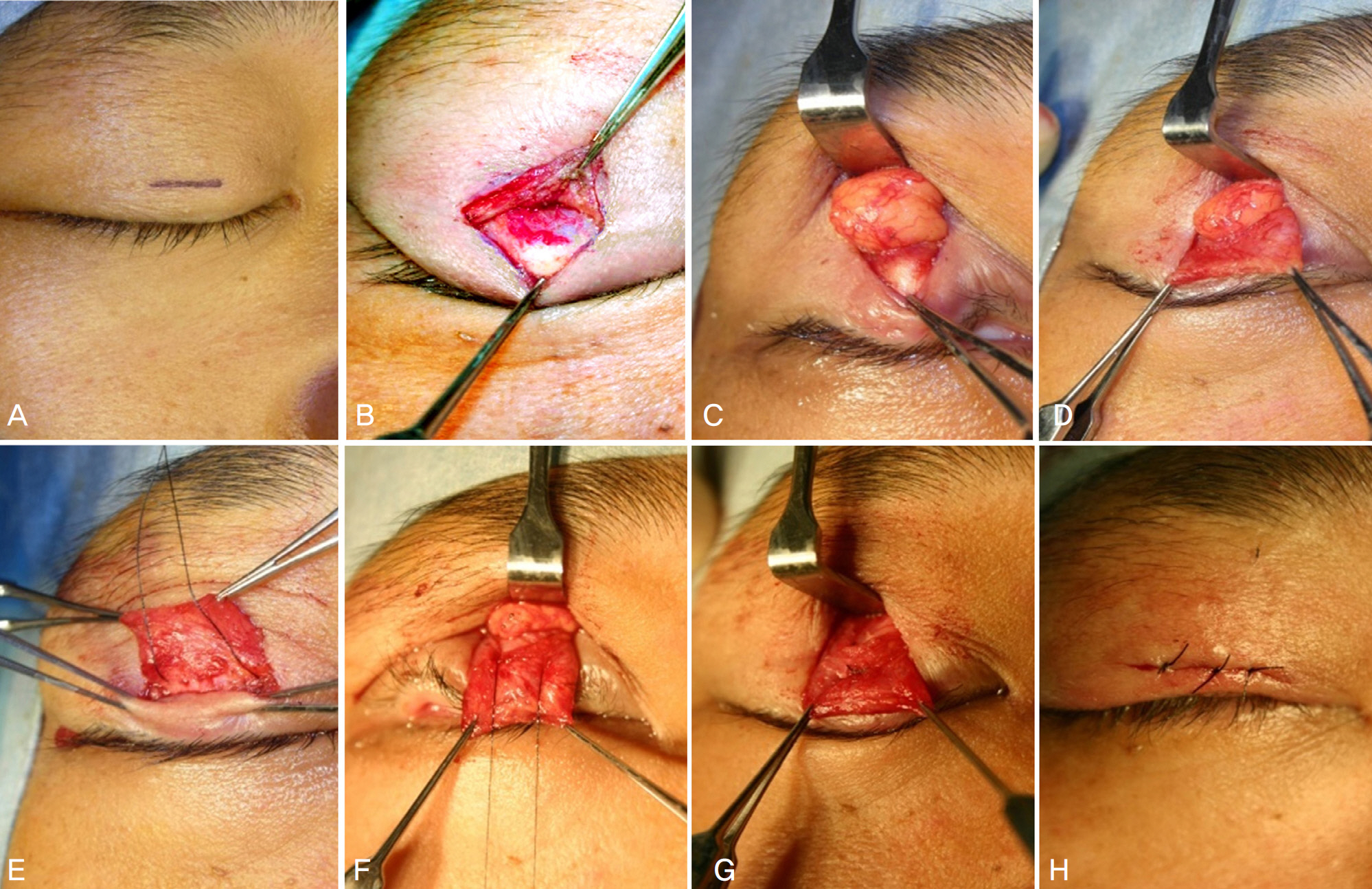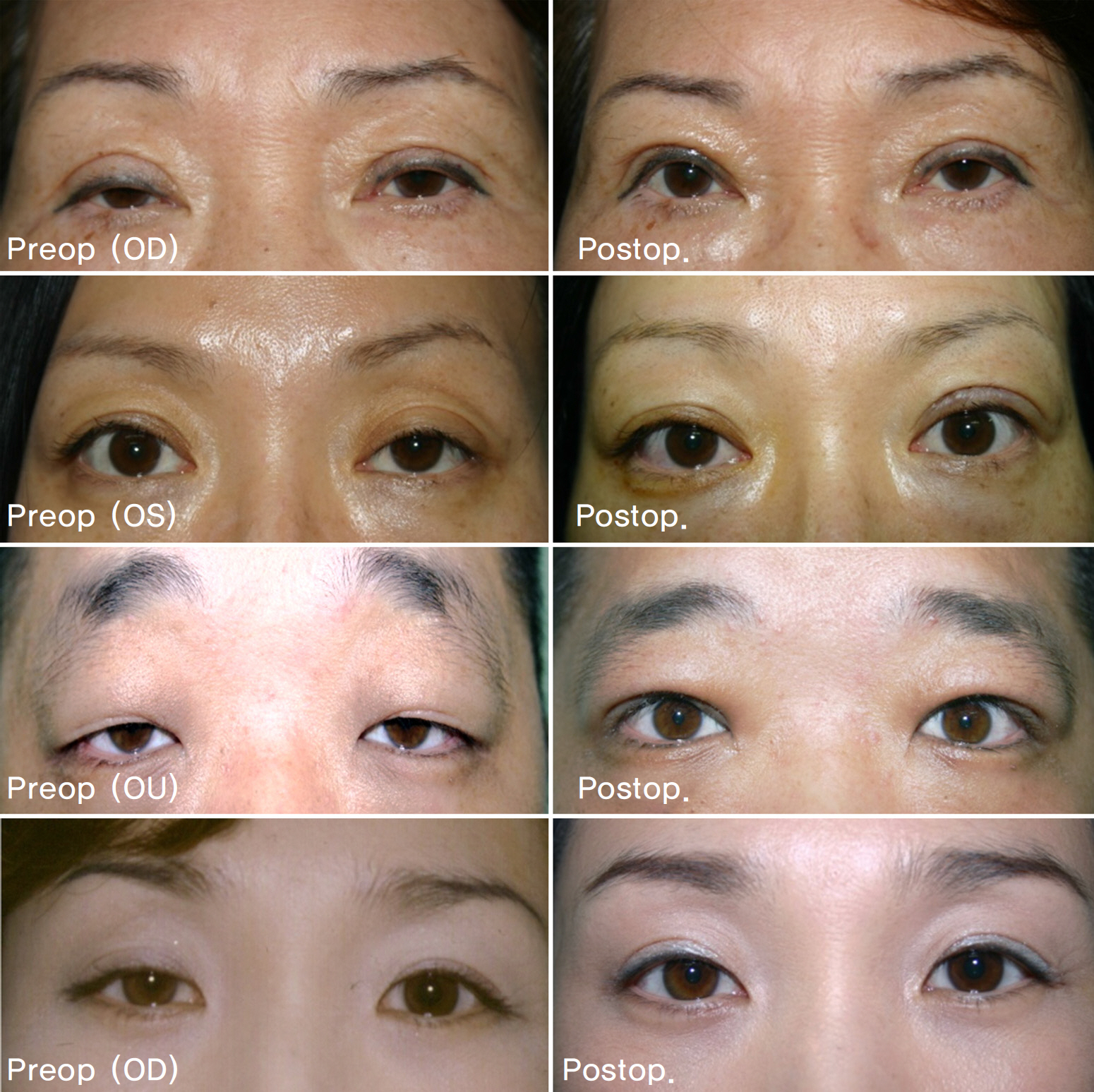J Korean Ophthalmol Soc.
2009 Aug;50(8):1146-1151. 10.3341/jkos.2009.50.8.1146.
Blepharoptosis Repair by Small Cutaneous Incision and Minimal Dissection Technique
- Affiliations
-
- 1Department of Ophthalmology, College of Medicine, The Catholic University of Korea, Seoul, Korea. laty@catholic.ac.kr
- KMID: 2212527
- DOI: http://doi.org/10.3341/jkos.2009.50.8.1146
Abstract
- PURPOSE
To present a simple method of acquired ptosis correction by small-incision minimal dissection technique and assess the results of the operation. METHODS: The charts of 23 patients (29 eyes) with acquired ptosis who underwent ptosis correction by small-incision minimal dissection technique were reviewed. Pre and postoperative MRD1, success rate, complications and reoperation rates were investigated. RESULTS: The average of pre- and postoperative MRD1 were 0.9+/-0.9 mm and 2.7+/-0.8 mm respectively. Of the 17 patients who underwent unilateral surgery, 15 eyes (88.2%) showed successful outcomes, and of the 12 eyes who underwent bilateral surgery, 8 eyes (66.6%), 2 eyes (16.7%), and 2 eyes (16.7%) showed excellent, good, and poor outcomes, respectively. Out of 29 eyes, 25 eyes (86.2%) showed satisfactory results. Two eyelids of unsatisfactory contour were corrected by reoperation. CONCLUSIONS: Although the small-incision minimal dissection technique for ptosis correction is applicable to a restricted group of patients compared to the conventional method, this technique is very useful and efficient, and has many advantages including less tissue damage, bleeding, edema, a short operation time and rapid recovery.
Keyword
Figure
Reference
-
References
1. Chung WS. Treatment of ptosis. Lee SY, Kim YD, Khwarg SI, Kim SJ, editors. Ophthalic plastic and reconstructive surgery. Seoul: NWHS;2004. 1:chap. 6.2. Dresner SC. Ptosis management: A practical approach. WP C, editor. Oculoplastic surgery: The essentials. New York: Thieme Medical Publishers;2001. 1:chap. 6.3. Iliff J, Pacheoco E. Ptosis surgery. Tasman W, Jaeger E, editors. Duane's clinical ophthalmology. Philadelpia: Williams and Wilkins;2001. 5:chap. 72.4. Lucarelli MJ, Lemke BN. Small incision external levator repair: technique and early results. Am J Ophthalmol. 1999; 127:637–44.
Article5. Baroody M, Holds JB, Sakamoto DK, et al. Small incision trans-cutaneous levator aponeurotic repair for blepharoptosis. Ann Plast Surg. 2004; 52:558–61.
Article6. Bernardini FP, de Conciliis C, Devoto MH. Mini-invasive ptosis surgery. Orbit. 2006; 25:111–5.
Article7. Frueh BR, Musch DC, McDonald H. Efficacy and efficiency of a new involutional ptosis correction procedure compared to a traditional aponeurotic approach. Trans Am Ophthalmol Soc. 2004; 102:199–206.8. Frueh BR, Musch DC, McDonald HM. Efficacy and efficiency of a small incision, minimal dissection procedure versus a traditional approach for correcting aponeurotic ptosis. Ophthalmology. 2004; 111:2158–63.9. Lee TS, Nam DH. Levator function, modified Fasanella-Servat operation, ptosis degree, srugical results. J Korean Ophthalmol Soc. 1999; 40:248–52.10. Moon HS, Lee JH, Baek SH. The frontalis sling operation using preserved fascia lata: modified crawford technique. J Korean Ophthalmol Soc. 2005; 46:10–5.11. Carter SR, Meecham WJ, Seiff SR. Silicone frontalis slings for the correction of blepharoptosis: indications and efficacy. Ophthalmology. 1996; 103:623–30.12. Everbusch O. Zur Operation der congenitalen Blepharoptosis. Klin Monatsbl Augenheilkd. 1883; 21:100–7.13. Jones LT, Quickert MH, Wobig JL. The cure of ptosis by aponeurotic repair. Arch Ophthalmol. 1975; 93:629–34.
Article14. Liu D. Ptosisrepair by single suture aponeurotic tuck. Surgical technique and long-term results. Ophthalmology. 1993; 100:251–9.15. Meltzer MA, Elahi E, Taupeka P, Flores E. A simplified technique of ptosis repair using a single adjustable suture. Ophthalmology. 2001; 108:1889–92.
Article16. Jeong S. Clinical study of simple levator resection in ptosis patients. J Korean Ophthalmol Soc. 2002; 43:551–5.17. Baek SH, Park MS, Park HJ. The effect of simplified single suture aponeurotic tuck in ptosis patients. J Korean Ophthalmol Soc. 2003; 44:1011–6.18. Lee JW, Shin DS, Lee KW. Small incision for ptosis repair. J Korean Ophthalmol Soc. 2008; 49:721–6.
Article
- Full Text Links
- Actions
-
Cited
- CITED
-
- Close
- Share
- Similar articles
-
- Blepharoptosis Repair through the Small Orbital Septum Incision and Minimal Dissection Technique in Patients with Coexisting Dermatochalasis
- Cases of Mild Ptosis Correction with Suture-Method
- Minimal-incision Tenorrhaphy in Flexor Tendon Injury
- Small Incision for Ptosis Repair
- A Comparative Study of Surgical Treatment in the Ruptured Achilles Tendon: Minimal incision and Open repair



